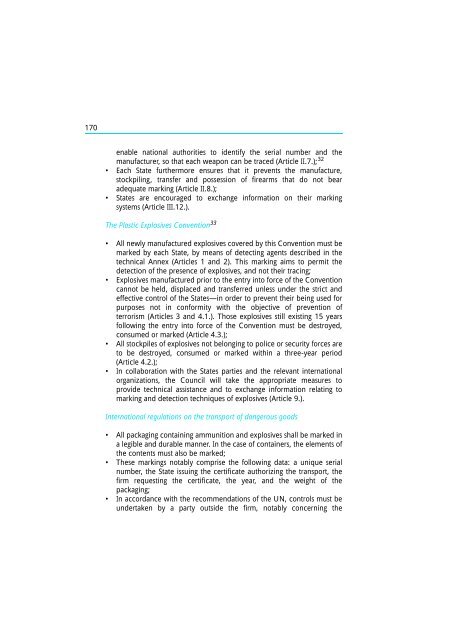The Scope and Implications of a Tracing Mechanism for Small Arms ...
The Scope and Implications of a Tracing Mechanism for Small Arms ...
The Scope and Implications of a Tracing Mechanism for Small Arms ...
You also want an ePaper? Increase the reach of your titles
YUMPU automatically turns print PDFs into web optimized ePapers that Google loves.
170<br />
enable national authorities to identify the serial number <strong>and</strong> the<br />
manufacturer, so that each weapon can be traced (Article II.7.); 32<br />
• Each State furthermore ensures that it prevents the manufacture,<br />
stockpiling, transfer <strong>and</strong> possession <strong>of</strong> firearms that do not bear<br />
adequate marking (Article II.8.);<br />
• States are encouraged to exchange in<strong>for</strong>mation on their marking<br />
systems (Article III.12.).<br />
<strong>The</strong> Plastic Explosives Convention 33<br />
• All newly manufactured explosives covered by this Convention must be<br />
marked by each State, by means <strong>of</strong> detecting agents described in the<br />
technical Annex (Articles 1 <strong>and</strong> 2). This marking aims to permit the<br />
detection <strong>of</strong> the presence <strong>of</strong> explosives, <strong>and</strong> not their tracing;<br />
• Explosives manufactured prior to the entry into <strong>for</strong>ce <strong>of</strong> the Convention<br />
cannot be held, displaced <strong>and</strong> transferred unless under the strict <strong>and</strong><br />
effective control <strong>of</strong> the States—in order to prevent their being used <strong>for</strong><br />
purposes not in con<strong>for</strong>mity with the objective <strong>of</strong> prevention <strong>of</strong><br />
terrorism (Articles 3 <strong>and</strong> 4.1.). Those explosives still existing 15 years<br />
following the entry into <strong>for</strong>ce <strong>of</strong> the Convention must be destroyed,<br />
consumed or marked (Article 4.3.);<br />
• All stockpiles <strong>of</strong> explosives not belonging to police or security <strong>for</strong>ces are<br />
to be destroyed, consumed or marked within a three-year period<br />
(Article 4.2.);<br />
• In collaboration with the States parties <strong>and</strong> the relevant international<br />
organizations, the Council will take the appropriate measures to<br />
provide technical assistance <strong>and</strong> to exchange in<strong>for</strong>mation relating to<br />
marking <strong>and</strong> detection techniques <strong>of</strong> explosives (Article 9.).<br />
International regulations on the transport <strong>of</strong> dangerous goods<br />
• All packaging containing ammunition <strong>and</strong> explosives shall be marked in<br />
a legible <strong>and</strong> durable manner. In the case <strong>of</strong> containers, the elements <strong>of</strong><br />
the contents must also be marked;<br />
• <strong>The</strong>se markings notably comprise the following data: a unique serial<br />
number, the State issuing the certificate authorizing the transport, the<br />
firm requesting the certificate, the year, <strong>and</strong> the weight <strong>of</strong> the<br />
packaging;<br />
• In accordance with the recommendations <strong>of</strong> the UN, controls must be<br />
undertaken by a party outside the firm, notably concerning the
















